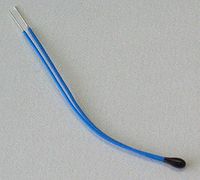Thermistor

Imagine you have a special thermometer that can tell you how hot or cold something is by changing its electrical resistance. This special thermometer is called a thermistor.
Now, let's imagine you have a toy car that you want to control so that it moves faster when it's hot outside and slower when it's cold outside. Here's where the thermistor comes in handy.
You can attach the thermistor to the toy car and connect it to a circuit. The circuit will measure the resistance of the thermistor and convert it into a voltage that can control the speed of the toy car.
When it's hot outside, the thermistor's resistance will be lower, and the voltage will increase, making the car move faster. When it's cold outside, the thermistor's resistance will be higher, and the voltage will decrease, making the car move slower.
In summary, a thermistor is a special thermometer that can be used to control a circuit, such as a toy car, by changing its electrical resistance as the temperature changes.
Now, let's imagine you have a toy car that you want to control so that it moves faster when it's hot outside and slower when it's cold outside. Here's where the thermistor comes in handy.
You can attach the thermistor to the toy car and connect it to a circuit. The circuit will measure the resistance of the thermistor and convert it into a voltage that can control the speed of the toy car.
When it's hot outside, the thermistor's resistance will be lower, and the voltage will increase, making the car move faster. When it's cold outside, the thermistor's resistance will be higher, and the voltage will decrease, making the car move slower.
In summary, a thermistor is a special thermometer that can be used to control a circuit, such as a toy car, by changing its electrical resistance as the temperature changes.
Related topics others have asked about:
